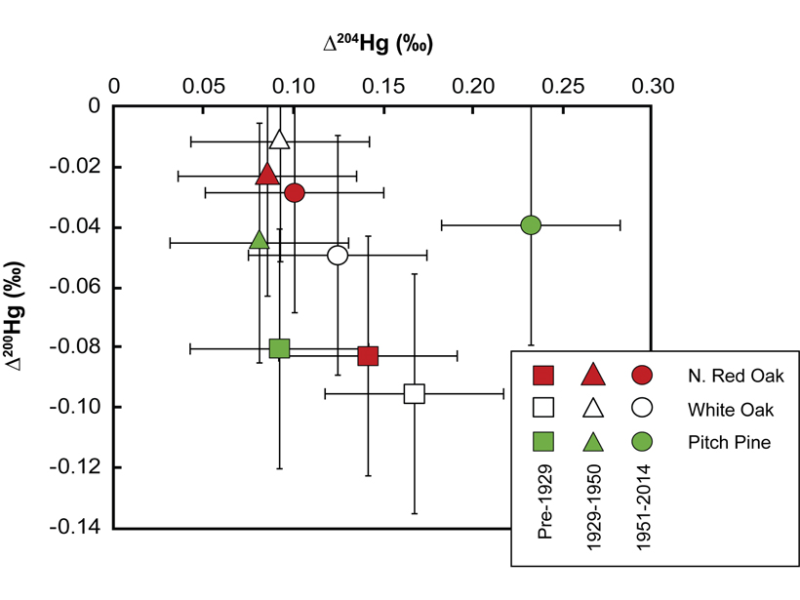Trees are Watching Us and Our Actions
Annual growth rings in trees tell us more than climate history; they can also document the rise and fall of human industrial activities.
SOURCE: Journal of Geophysical Research: Biogeosciences

Mercury (Hg) stable isotope concentrations in tree rings can be used to differentiate anthropogenic and background contributions to accumulated mercury in tree rings. Positive Δ204Hg and negative Δ200Hg indicate primarily atmospheric source for tree mercury. Here, mass-independent fractionation values for these isotopes across three species in three eras suggests that local industrial sources of atmospheric mercury contributed strongly to tree-ring mercury from 1920-1950. This is indicated by near zero even-mass mass-independent fractionation values for mercury isotopes, indicating shorter atmospheric residence time. Credit: Scanlon et al. [2020], Figure 3
The annual growth of trees through photosynthesis is demarcated in seasonal growth rings put on in their stems. Rind width and composition provide clues about the conditions under which that individual grew. These "tree rings" have been used for decades to reconstruct past climates and extreme events. However, there is more to the story.
Scanlon et al. [2020] discover that the concentration of mercury in decadal increments can be used to reconstruct atmospheric mercury in a set of trees in Virginia, USA. Using concentration observations, the researchers found that mercury concentrations in tree rings peaked in the 1930s–1950s while global atmospheric mercury continued to rise. Mercury stable isotopes reveal that this local peak was linked to a local pollution source, most likely from a nearby industrial plant that manufactured the synthetic fabric rayon.
This study is the first attempt to analyze and interpret mercury isotopes in tree rings. The findings open the doors to new analytical approaches to tease out the stories hidden in tree rings about the history of human industrial activity and its impact on the biosphere.
Citation: Scanlon, T. M., Riscassi, A. L., Demers, J. D., Camper, T. D., Lee, T. R., & Druckenbrod, D. L. [2020]. Mercury accumulation in tree rings: Observed trends in quantity and isotopic composition in Shenandoah National Park, Virginia.Journal of Geophysical Research: Biogeosciences, 125, e2019JG005445. https://doi.org/10.1029/2019JG005445
—Ankur Rashmikant Desai, Editor,JGR: Biogeosciences
AGU发布最新国外工作学习机会:
1. Fall Research Experiences for Undergraduates (REU) Program
Bermuda (BM)
Stipend of $500 per week for 12 weeks
Bermuda Institute of Ocean Sciences
A 12-week REU internship at BIOS is an ideal way to gain the experience necessary to embark on graduate studies or careers in oceanography and the marine and atmospheric sciences.
2. Postdoctoral Associate - Center for Global Change Science/AGAGE
Cambridge, Massachusetts (US)
Massachusetts Institute of Technology (MIT)
MIT is seeking a postdoc associate to join an international team of experimentalists and theoreticians.
https://findajob.agu.org/job/8012122/postdoctoral-associate-center-for-global-change-science-agage/
3. Postdoctoral Researcher, Ecohydraulics and Transport Phenomena in Rivers
Columbia, Missouri
Columbia Environmental Research Center
GS-12, 76,000 - 99, 000 per year
We seek a postdoctoral fellow with a strong background in hydraulics, turbulence, hydrodynamic modeling, and aquatic ecology; substantial flexibility exists for determining the scope and approach of each project.



